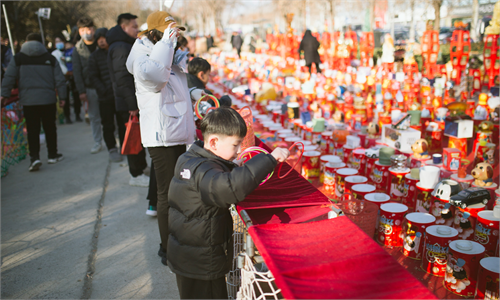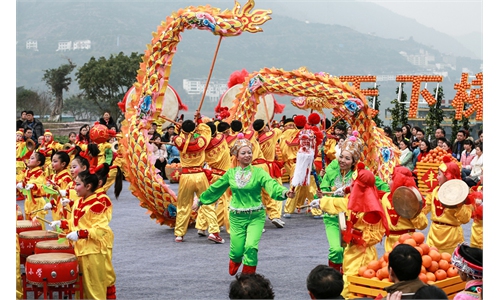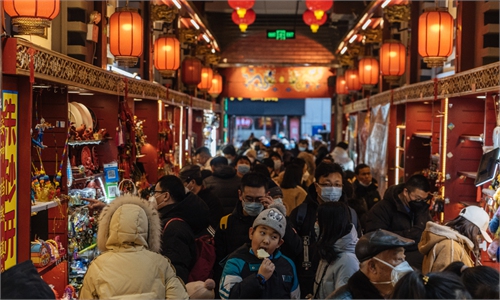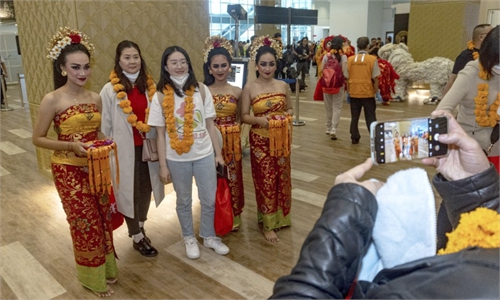Chinese enjoy warm, safe Spring Festival holidays as most places have passed infection peak
Full preparations for epidemic contribute to controllable situation in China
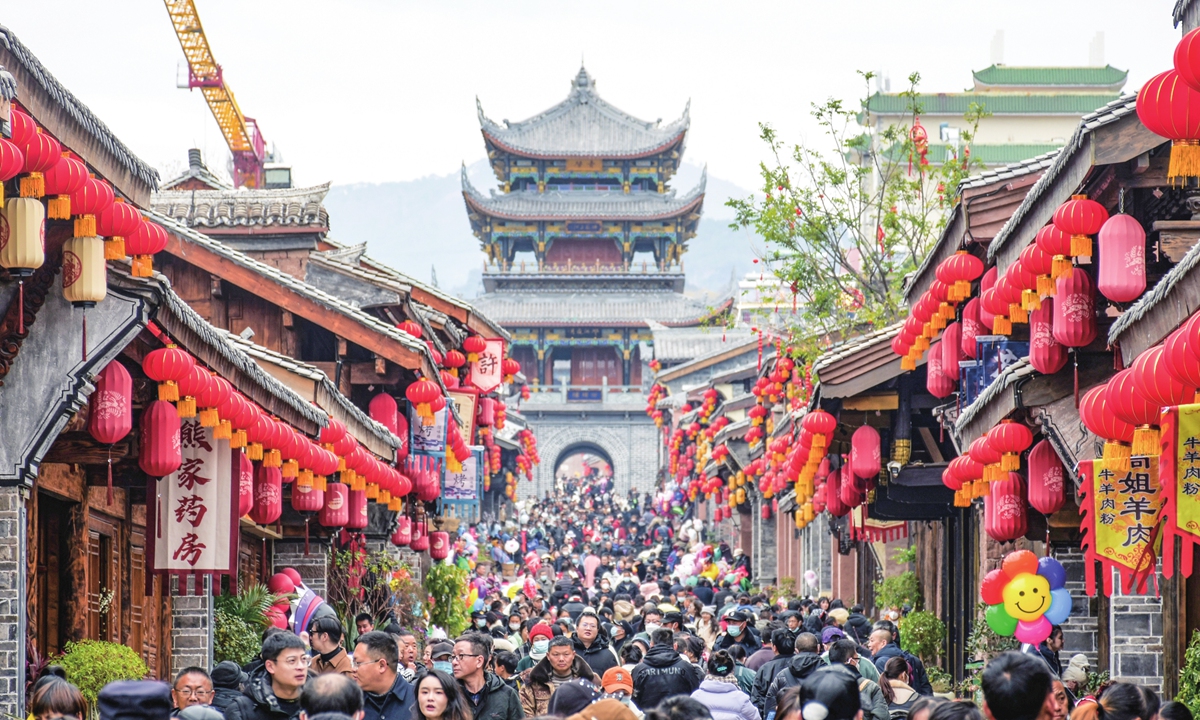
Tourists throng the streets of Xichang, Liangshan Yi Autonomous Prefecture, Sichuan Province on January 27, 2023. During the Spring Festival, Xichang received more than 100,000 tourists a day during the peak period. Photo: VCG
Railway stations and airports across China in the past few days have embraced the busiest period in almost three years as they were flooded with hugs, tears and joy. Highways were congested with cars full to the brim with hometown specialties, and after celebrating a warm and happy Spring Festival holiday with their loved ones, Chinese people are imbued with a refreshed spirit and wishes to usher in the Year of the Rabbit.
This Spring Festival holiday was particularly special for every Chinese - it was the first holiday after China announced the downgrading of COVID-19 management from Class A to Class B in early January. After the whole country went through a surge in COVID infections in December and early January, people's emotions were a mixture of worry and excitement as more people chose to go back to their hometowns to have a family reunion for the Chinese New Year, after the ritual has been absent for the past three Spring Festivals for many families.
With full preparations by governments at all levels and the hard work of medical staff, big and small cities, counties and villages across China had already passed the infection peak and were able to cope with a smaller number of COVID-19 patients in clinics than anticipated during the holiday. As the whole epidemic situation in China is under control, people's lives are back to normal and the country is expected to embrace an economic rebound.
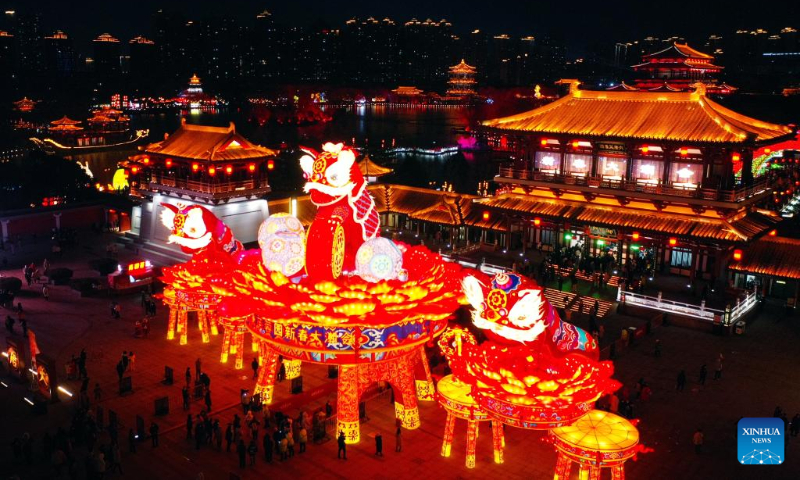
This aerial photo taken on Jan. 24, 2023 shows the lanterns at the Tang Paradise in Xi'an, northwest China's Shaanxi Province. Chinese scenic spots are welcoming legions of tourists with a variety of festive activities during the Spring Festival holiday. (Xinhua/Liu Xiao)
Pleasant festivalThe whole country has been in the grip of a widespread Spring Festival vibe in late January. Residents of Guangzong county in Hebei Province flocked to outdoor markets, malls and parks that were decked with red lanterns and Spring Festival couplets to watch lion dance and acrobatic performances. The laughter of running children, sellers touting their wares and cheers from crowds for performers added more joy amid the cold winter.
A villager surnamed Liu was busy buying decorations for good luck and was happy to see the hustle and bustle in the market. "After three years, we finally got over the epidemic. My children who are working in different cities are coming home. I've come to buy decorations to make the house more festive!" Liu told the Global Times.
One nucleic acid testing site in the county in front of the Traditional Chinese Medicine Hospital, where there used to be queues that extended for several meters, was closed. Some locals who passed by said that the three-year battle against the virus felt like something that happened in the distant past, and that the past busy days have returned.
Joyful scenes appeared across China. In the southern towns of East China's Anhui Province, residents made meatballs - indicating family reunion - spring rolls and other traditional food to welcome their relatives home. At local wholesale markets, the Global Times reporter saw people busy purchasing fruits and other agricultural products before Chinese New Year's Eve, which fell on January 21.
A local restaurant employee in Ningguo county in Anhui told the Global Times that all the table's for Chinese New Year's Eve dinner in his restaurant were fully booked.
A hospital employee surnamed Zhang from Xuanzhou area in Anhui told the Global Times that this year, most of the medical staff in the hospital where he works could at least enjoy Chinese New Year's Eve dinner with their family as the COVID-19 infections started to decline about two weeks before Spring Festival. "During the Spring Festival, the epidemic [situation] is relatively stable and the hospital has prepared fully with ensuring on-duty staff for 24-hour and sufficient medicine stock," Zhang said.
The epidemic restrictions being lifted as well as the decline in infections in Chinese cities encouraged the travel boom. During the Spring Festival holiday, scenic spots welcomed hordes of tourists with a range of festive events. For instance, Xi'an of Shaanxi Province has experienced a 571 percent rise in trans-provincial visits compared to the previous year.
In the southern metropolis of Guangzhou, Guangdong Province, the traditional flower fairs ahead of the Chinese New Year resumed, bringing back hundreds of stalls selling flowers, crafts and snacks, while lively performances such as lion dance were also on offer.
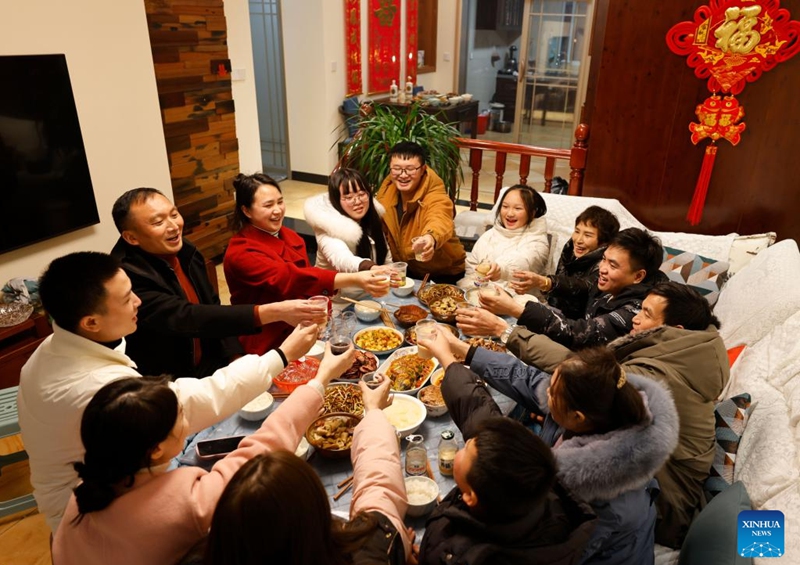
People enjoy a family feast on the eve of the Spring Festival in Zunyi, southwest China's Guizhou Province, Jan. 21, 2023. On the eve of the Spring Festival in China, while some people reunite with their families and friends, there are others who still stick to their posts away from home. Nevertheless, nothing can stop a warm gathering and delicious festive dinner while they await the arrival of the Spring Festival. (Photo by Zhao Yongzhang/Xinhua)
Not let guard downWhile Chinese people have been enjoying the festival, the country has not let its guard down over the management of COVID-19.
The Global Times learned that hospitals in many places across China made emergency plans for a possible infection surge during the holiday and medical staff were required to be on standby in case of any major outbreaks.
Before and during the Spring Festival holiday, Chinese health authorities had made preparations, putting rural areas as the top priority of the anti-epidemic work and calling for careful arrangement of medical resources and services for key groups like the elderly and children.
Unlike some Western media reports that predicted China's rural areas and small cities would see mass infections following the Spring Festival holidays, the Global Times learned from different localities that the numbers of positive cases have been largely declining during the holidays while some third- and fourth-tier cities have already passed the infection peak.
A doctor surnamed Wu, owner of a clinic in Hengfeng county, East China's Jiangxi Province, told the Global Times on Wednesday that there had been no COVID-19 patients seeking treatment in her clinic during the Spring Festival holiday so far, as the infection peak in the county had passed.
Wu received nearly 30 patients during the half-month infection peak from December 19, 2022 to early January.
The majority were aged between 50 and 80, she said, noting that there were five or six COVID patients aged over 80. Some were coughing, some reporting chest pain, some with bloody sputum, vomiting or body aches, Wu said, noting that antipyretics, antivirals and intravenous drips to reduce inflammation were the common treatment in response to the symptoms. All the patients she treated have recovered and none was transferred to the county hospital.
With full preparations, most of the places have steadily gone through the infection surge, making the overall epidemic situation in China controllable, analysts said.
According to the latest report from the Chinese Center for Disease Control and Prevention (China CDC), overall visits to fever clinics nationwide reached a peak of 2.87 million on December 23, 2022 and dropped to 63,000 on January 23. Visits to fever clinics in rural areas peaked on December 23, 2022 at 922,000, declining 94.6 percent from their peak to 50,000 on January 23.
Small-scale infections may occur in the future but it will not be like the infection peak in December of 2022 as most of the population has been infected, Wang Guangfa, a respiratory expert from Peking University First Hospital, told the Global Times
Wang noted that in June, the infection will be stable as the virus is not active in the summer season. But more preparations should be made, including updating vaccines and testing strains of the virus for the winter in 2023.
While China has overcome the infection peak smoothly and enjoyed the Spring Festival holiday, the World Health Organization is mulling whether the COVID outbreak still meets the definition of a public health emergency of international concern - the agency's highest risk level. However, some Western media are hyping the epidemic situation in China, claiming that COVID is running rampant in China and the infection surge has prolonged the global pandemic.
Wang refuted that China's epidemic is not the reason for the WHO considering announcing the pandemic is over. The COVID-19 epidemic is a public health event that concerns all people as the virus has experienced mutations and has stronger infectivity in less time.
When to announce the end of the pandemic depends on herd immunity, the infectivity of the virus in humans and the situation of mass vaccination, Wang said.
